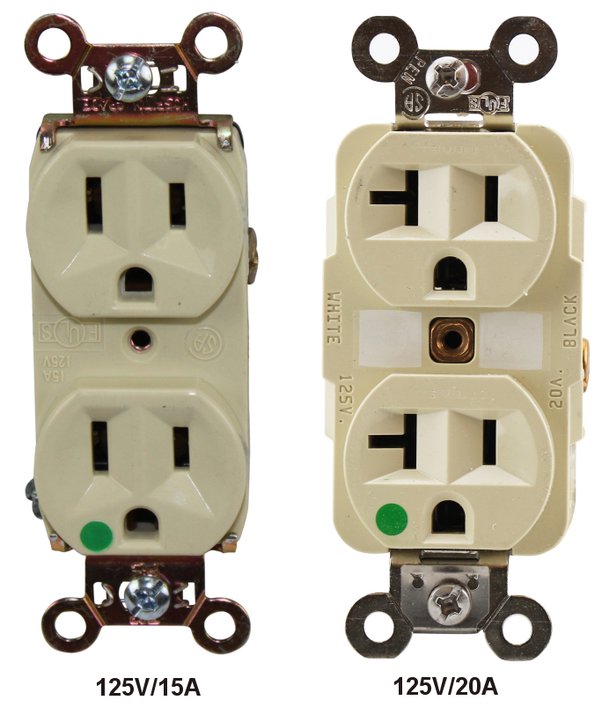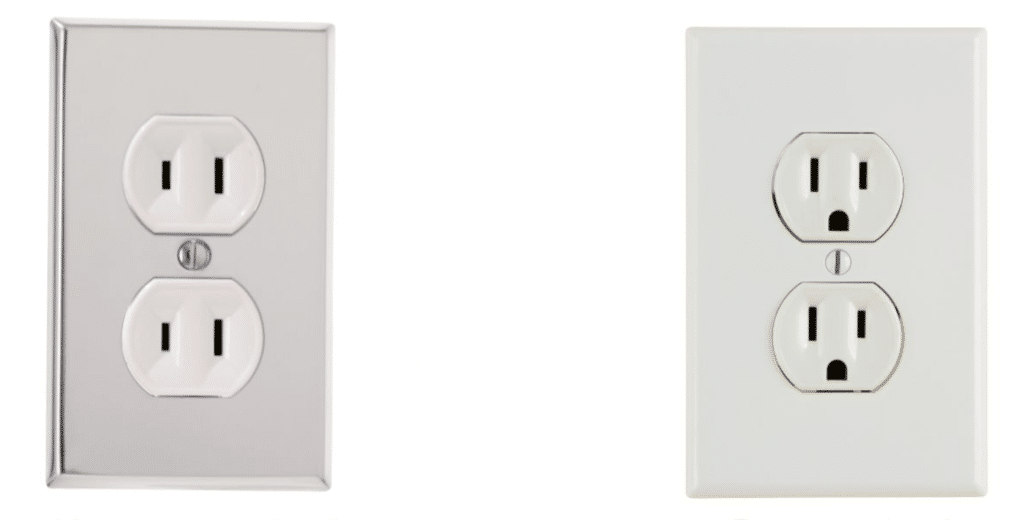If you’re looking to repair an outlet in your home, you’ve probably found yourself looking at the choices in the store and wondering what kind you actually need.
Things quickly become perplexing when working with electricity. So in this article, we’ll explain the differences between the two most common types: 15 Amp and 20 Amp wall outlets.
Difference Between 15 Amp and 20 Amp Outlets
The main difference between these two types of wall outlets is in the devices they power. 15 Amp outlets power low-amp devices like lamps and TVs, while 20 Amp outlets power high-amp appliances like washing machines, dryers, and microwaves.
You can switch one for the other without changing the outlet’s circuit in only one direction. In other words, the 20 Amp circuit supports 15 Amp and 20 Amp outlets, but a 15 Amp circuit only supports 15 Amp power plugs.

To help you fully grasp their uniqueness, let’s start at the very beginning by describing how electricity enters your home.
The Flow of Electricity
Have you ever wondered how electricity gets to the 15 Amp and 20 Amp outlets? Everything begins in power plants, where massive rotating turbines turn the wind, coal, natural gas, or water into electricity.
The electrical current is then transferred into transmission lines spanning great distances through transformers. From there, the energy gets to a substation, where its power is reduced and sent to smaller power lines.
Next, the electricity is distributed to each neighborhood via distribution wires and into transformers. There the power intensity is reduced once more so that it’s secure for household use.
The electricity connects to our homes through a main circuit panel, into the cables inside the walls, and finally to our home’s outlets and switches.
From there, you’re able to plug in a gadget or flip a switch and see it work. But does this process have to do with 15 Amp and 20 Amp wall outlets?
In-Depth Comparison of 15 Amp and 20 Amp Wall Outlets

By now, we’ve learned the main difference between 15 Amp and 20 Amp wall outlets, why they’re not interchangeable, and how electricity comes to them. With this knowledge, we’re ready to dive deeper and better discriminate between the two types.
Appearance
Physically, 15 amp and 20 amp outlets are the same dimensions. The main visual difference is their receptacle slots.
The 15 Amp power plug has a rounded “U” slot for the ground, one short vertical slot for the hot, and one long slot for the neutral wire.
The ground and hot slots of the 20 Amp outlet are the same as those of the 15 Amp one, but the neutral slot has a horizontal “T” shape.
The spaces of the 20 Amp outlet have one fantastic quality. The neutral slot’s upright portion is the same height as a standard 15 Amp neutral one, specifically designed to fit both plugs into the socket!
Circuit Breaker
The most common circuit breakers in homes are 120V 15 Amp and 120V 20 Amp circuits.
A 20 Amp circuit handles both the 20 Amp and 15 Amp outlets. However, a 15 Amp circuit can only support the 15 Amp outlet. Installing a 20 Amp outlet on a 15 Amp circuit will cause an electric overload and possibly start a fire.
Power
Most households within the US have 120-volt electric circuits with wall outlets of 15 Amp or 20 Amp of electricity.
With a 15 Amp outlet, you can plug devices that pull up to 1800 Watts of electricity (120V x 15 Amp = 1800W). Such wattage is adequate for low and medium-wattage gadgets, including computers, televisions, gaming consoles, table lamps, modems, digital clocks, and power adapters for smartphones, tablets, laptops, or iPads.
A 20 Amp outlet handles up to 2400 Wattage (120V x 20 Amp = 2400W). Because of the higher wattage rating, this wall outlet is able to charge high-wattage appliances, such as air conditioners, fridges, freezers, ovens, blenders, toasters, and so on.
Wire Gauge
Wire gauge is a measurement of cable thickness. It determines how much electric power the wire can securely transport.
Each wire gauge is symbolized by a digit, with lower numbers indicating thicker wires and higher numbers signifying thinner wires.
Fifteen Amp outlets usually use 14-gauge wires, while 20 Amp outlets generally use 12-gauge wire or 10-gauge wires.
Price
A 15 Amp outlet costs between $3 and $5, while a 20 Amp outlet costs between $10 and $20.
Fifteen Amp outlets are much more affordable than 20 Amp ones and require less expensive 14-gauge wires. As a result, the overall installation is more cost-effective, which is why they are so popular. Nevertheless, their lower price comes at the expense of lower wattage capability compared to the 20 Amp outlets.
As we already mentioned, the 20 Amp outlet is more pricy. In addition, it requires more expensive 12 gauge or 10 gauge wires. However, their high-end price means your outlets will have a greater wattage capacity for powering your devices and appliances without you worrying about electric overload.
Constructing your circuits mindfully will allow you to save money in the future. For example, install a 120V 20 Amp circuit breaker where you can use both 15 Amp and 20 Amp outlets. Install 15A outlets in places around your home where you usually plug low or medium-wattage appliances, and reserve the more expensive 20 Amp outlets for the more heavy-duty ones, usually found in the kitchen and laundry room.
Grounded vs. Ungrounded Outlet Comparison Table
| Category | 15 Amp Outlet | 20 Amp Outlet |
|---|---|---|
| Outlet Appearance | Short vertical slot for the hot wire, long slot for the neutral wire, “U” slot for the ground wire | Short vertical slot for the hot wire, horizontal “T” slot for the neutral wire, “U” slot for the ground wire |
| Usual circuit type | 120V 15 Amp or 20 Amp circuit | 120V 20 Amp circuit |
| Wattage capacity | 1800W | 2400W |
| Suitable plug-ins | Low and medium-wattage gadgets: computers, televisions, gaming consoles, table lamps, modems, digital clocks, and power adapters for smartphones, tablets, or laptops | High-wattage appliances: air conditioners, fridges, freezers, ovens, blenders, or toasters |
| Wire gauge | 14-gauge wires | 12-gauge wires |
| Price | Less expensive ($3 to $5 per outlet) | More expensive ($10 to $20 per outlet) |
Conclusion
Electrical outlets are an essential component of our homes’ electrical infrastructure, enabling us to plug in various electrical appliances and devices.
The two most prevalent types are the 120V 15 Amp outlet and the 120V 20 Amp outlet. In this article, we covered their key differences. So let’s briefly sum up.
The 15 Amp wall outlet has 1800W capacity and is ideal for powering your PCs, TVs, modems, and other low or medium-wattage gadgets. On the other hand, the 20 Amp wall outlet has a 2400W capacity and is powerful enough to support refrigerators, ovens, washing machines, and other heavy-duty appliances.
We hope our guide helped you understand the distinctions between these wall outlets. So, if you are considering rewiring your home electrically, you’ll know how to select the appropriate outlet.
Your table is in error.
Your article correctly stated that a 20 amp outlet CANNOT be put on a 15 amp circuit.
“A 20 Amp circuit handles both the 20 Amp and 15 Amp outlets. However, a 15 Amp circuit can only support the 15 Amp outlet.
Installing a 20 Amp outlet on a 15 Amp circuit will cause an electric overload and possibly start a fire”
However your table indicates that a 20 amp circuit can be put on a 15 amp circuit
Category 15 Amp Outlet 20 Amp Outlet
Usual circuit type 120V 15 Amp circuit 120V 20 Amp or 15 Amp circuit
Interesting article otherwise
Hi Richard, thanks very much for catching this transposition of data. I’ve just corrected it. Thanks for reading.